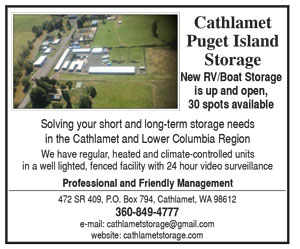Current fishery situation is not sustainable
December 28, 2017
To the Eagle:
I feel compelled to comment on the article in the Eagle (12/21/17) from the Columbia Basin Bulletin, “Group Tests Fish Trap above Cathlamet.” I attended the Wild Fish Conservancy presentation to the Washington Fish and Wildlife Commission and noted several inaccuracies, and the CBB added a few more.
1. Fish traps were never the “massive” harvest technology on the Columbia. They were outlawed in 1936 in Washington and 1948 in Oregon because many, if not most, were vertically integrated with the fish packers, and were being used to manipulate fish prices. I confronted one of the Wild Fish Conservancy people on this, and he admitted this was the case.
2. The statement that fish traps are more selective than gillnets is a gross distortion and sets up a false dichotomy. Gillnets are selective by time, area fished, mesh size, i.e. when you fish, where you fish, and the gear you fish. Avoidance of encounters during peak abundance of a critical limiting stock, or passing them through the net by using appropriate mesh size are the main features of gillnet fisheries from the Columbia River to the Arctic Ocean.
Alternative gears such as traps and seines in themselves are not selective. They catch everything. Selectivity is achieved by manual sorting of the catch. Any time fish are handled there will be mortalities, and they increase substantially as water temperatures rise in summer and fall. While the actual mortality rate from alternative gear will likely be lower, the large volumes of fish handled and sorted makes the aggregated number of non-target fish killed significantly higher.
The most recent example of gillnet selectivity is the heavily monitored fall chinook August and September fishery from St. Helens to Bonneville. In 2017 this fishery harvested 19,000 fall chinook with six kills of Wild B run steelhead, the most critical stock. It doesn’t get much more selective than that.
3. The article commented that the mortality rate of the tangle net is 20%. What was not mentioned is that tangle nets are fished in areas and times where the presence of marked hatchery fish, the target species, is in excess of 80%. The real mortality rate of fall coho in October is actually 20% of the 20% of the non-target natural spawn coho that are passing through the fishery, again a very high standard of selectivity.
4. I note that in the presentation to the WFWC and in the Bulleting article, the number of actually saleable fish is never mentioned. The 7129 salmonids captured by the trap likely included steelhead and jacks, which are not saleable. These numbers are not helpful in assessing the trap’s utility as a commercial fishing tool, as to whether it might be profitable or not.
5. I point out that after seven years of experimentation, the agencies still have not been forth-coming about the numbers of fish they want harvested, and when and where they want them harvested. Why would anyone invest in excess of $100,000 in any alternative gear in the absence of a firm commitment that fish will be available for harvest? Right now, WDFW’s policy of sport priority nullifies the financial prospects of any potential alternative gear, since there is no guarantee that adequate fish will be available for commercial harvest.
6. The over-arching question regarding “harvest reform” is “Where are the conservation benefits?” A dead fish is a dead fish, no matter what gear, recreational or commercial, is used. Previously, allowable incidental kills of ESA listed salmonids had been shared roughly 50/50 between sport and commercial fisheries. The new policy shifted the balance to 75% recreational in Washington, 70% recreational in Oregon. No listed fish have been saved. Huge hatchery surpluses have occurred, due to the recreational fishery’s inability to capture them. This situation has prompted those paying for salmon mitigation to wonder why they are raising fish that no one is able or allowed to catch.
The promised expansion of select areas where commercial fishers can harvest returning hatchery fish after they have passed through the sport fishery has not produced anything like the promises made in Oregon, and has been a complete failure in Washington.
7. The hatchery and natural spawn surpluses that the sport fishery cannot begin to address prompt three possible solutions, in my view. 1. Continue to reduce hatchery production; 2. Restore the commercial mainstem fishery to something like it was before 2012; or 3. Encourage a tribal fishery presence in the lower river. The latter may well happen if the states continue to dither. The current situation is not sustainable.
Kent Martin
Skamokawa








Reader Comments(4)
Fishinexcess writes:
I had to laugh when I read the above letter that states gillnets are selective. I have gillnetted salmon (and herring) for over fifty years and can say from hard-earned experience that gillnets are not selective. Gillnets take the weak, endangered stocks along with the strong. Gillnets are indescriminate salmon and steelhead killing machines. If you want to fish selectively and avoid handling the salmon and steelhead, then fish with a trap or wheel.
12/28/2017, 1:18 pm
Accuraculture3 writes:
Accuraculture robotic smart gear type (count escapement/release capture hold) Systems menu and or/licence options Solutions Shareholders: Permits ( harvest ticket assets) timing Process (capacity capital) and logistics. On account financial securities standard menu to exchange region-of-origin (renewable-grade) signature ledger information, that seafood customers may trade and/or trace anywhere along the digital supply chain, even at the point-of-sale and/or on-demand license options
12/28/2017, 1:01 pm
Accuraculture2 writes:
Accuraculture robotic (count escapement release capture hold) Systems smart gear type Solutions Shareholders: Permits (ticket assets harvest) timing process (capacity capital) on-account Financial securities exchange standard digital signature ledger region-of-origin (renewable-grade) information seafood customers can trade and or trace anywhere along the supply chain, even at the point-of-sale
12/28/2017, 11:55 am
Accuraculture1 writes:
Accuraculture robotic (count escapement release capture hold) Systems smart gear type Solutions Shareholders: Permits ticket assets harvest timing possess capacity capital on account Financial securities exchange standard digital signature ledger region of origin (renewable-grade) information seafood customers can trade and or trace anywhere along the supply chain, even at the point-of-sale
12/28/2017, 11:50 am